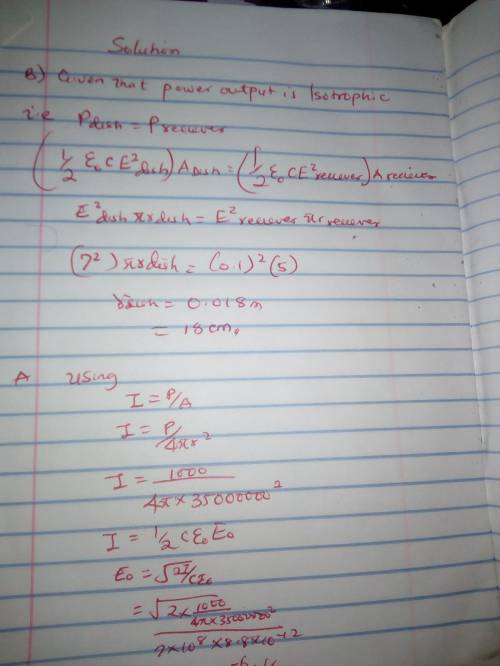
A satellite in geostationary orbit is used to transmit data via electromagnetic radiation. The satellite is at a height of 35,000 km above the surface of the earth, and we assume it has an isotropic power output of 1.0 kW (although, in practice, satellite antennas transmit signals that are less powerful but more directional).
Required:
a. Reception devices pick up the variation in the electric field vector of the electromagnetic wave sent out by the satellite. Given the satellite specifications listed in the problem introduction, what is the amplitude E0 of the electric field vector of the satellite broadcast as measured at the surface of the earth? Use ϵ0=8.85×10^−12C/(V⋅m) for the permittivity of space and c=3.00×10^8m/s for the speed of light.
b. Imagine that the satellite described in the problem introduction is used to transmit television signals. You have a satellite TV reciever consisting of a circular dish of radius R which focuses the electromagnetic energy incident from the satellite onto a receiver which has a surface area of 5 cm^2. How large does the radius R of the dish have to be to achieve an electric field vector amplitude of 0.1 mV/m at the receiver?

Answers: 3


Other questions on the subject: Physics

Physics, 21.06.2019 23:30, xxxamslashxxx9
If 21.2 kcals of energy is released by this reaction, how many kj does the reaction release? (1 cal 4.184 j)
Answers: 1


Physics, 22.06.2019 12:20, cxttiemsp021
Which lists the pairs of plates in order from least to greatest in terms of the work done to move the electron?
Answers: 2

Physics, 23.06.2019 01:00, exoticbunnylover123
Learning goal: to understand newton's 1st law. newton's principia states this first law of motion: an object subject to no net force maintains its state of motion, either at rest or at constant speed in a right line. this law may be restated as follows: if the sum of all forces acting on an object is zero, then the acceleration of that object is zero. mathematically this is just a special case of the 2nd law of motion, f⃗ =ma⃗ , when f⃗ =0. when studying newtonian mechanics, it is best to remember the 1st law in two ways: if the net force (i. e., sum of all forces) acting on an object is zero, the object will keep moving with constant velocity (which may be zero). if an object is moving with constant velocity, that is, with zero acceleration, then the net force acting on that object must be zero. complete the following sentences to see if you can apply these ideas. part a if a car is moving to the left with constant velocity, one can conclude that
Answers: 1
You know the right answer?
A satellite in geostationary orbit is used to transmit data via electromagnetic radiation. The satel...
Questions in other subjects:

Mathematics, 16.12.2020 23:30

SAT, 16.12.2020 23:30


Chemistry, 16.12.2020 23:30



Mathematics, 16.12.2020 23:30

Physics, 16.12.2020 23:30

Health, 16.12.2020 23:30




